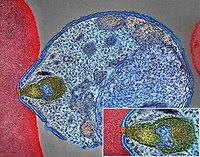
Photo from wikipedia
BACKGROUND Infections and inflammation lead to a downregulation of drug metabolism and kinetics in experimental animals. These changes in the expression and activities of drug-metabolizing enzymes may affect the effectiveness… Click to show full abstract
BACKGROUND Infections and inflammation lead to a downregulation of drug metabolism and kinetics in experimental animals. These changes in the expression and activities of drug-metabolizing enzymes may affect the effectiveness and safety of pharmacotherapy of infections and inflammatory conditions. OBJECTIVE In this review, we addressed the available evidence on the effects of malaria on the drug metabolism activity and kinetics in rodents and humans. RESULTS An extensive literature review indicated that infection by Plasmodium spp consistently decreased the activity of hepatic Cytochrome P450s and phase-2 enzymes as well as the clearance of a variety of drugs in mouse (lethal and nonlethal) and rat models of malaria. Malaria-induced CYP2A5 activity in the mouse liver was an exception. Except for paracetamol, pharmacokinetic trials in patients during acute malaria and in convalescence corroborated rodent findings. Trials showed that, in acute malaria, clearance of quinine, primaquine, caffeine, metoprolol, omeprazole, and antipyrine is slower, and that AUCs are greater than in convalescent individuals. CONCLUSION Notwithstanding the differences between rodent models and human malaria, studies in P. falciparum and P. vivax patients confirmed rodent data showing that CYP-mediated clearance of antimalarials and other drugs is depressed during the symptomatic disease when rises in levels of acute phase proteins and inflammatory cytokines occur. Evidence suggests that inflammatory cytokines, and the interplay between malaria-activated NF-kB-signaling and cell pathways controlling phase 1/2 enzyme genes transcription mediate drug metabolism changes. Malaria-induced decrease in drug clearance may exacerbate drug-drug interactions, and occurrence of drug adverse events, particularly when patients are treated with narrow-margin-of-safety medicines.
Journal Title: Current drug metabolism
Year Published: 2021
Link to full text (if available)
Share on Social Media: Sign Up to like & get
recommendations!